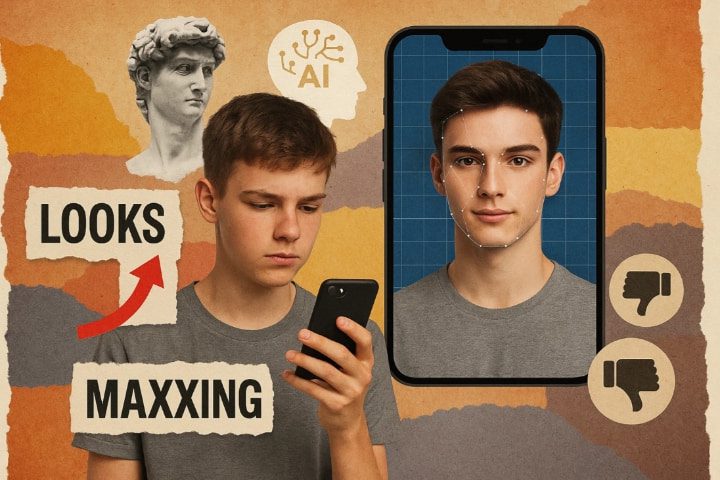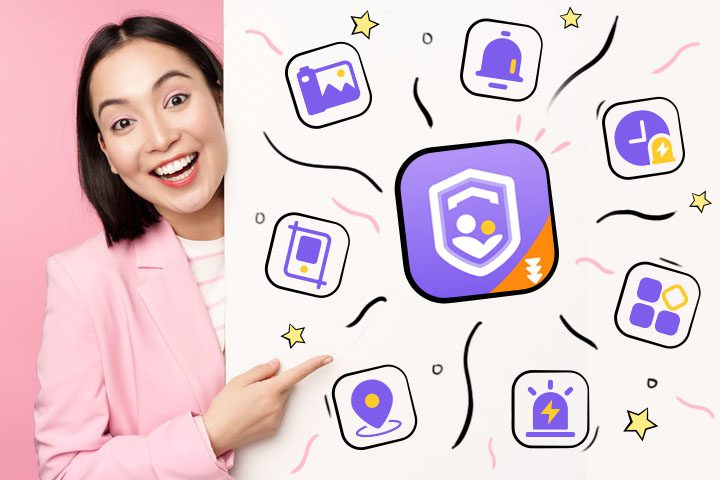Looksmaxxing AI is transforming the way youth perceive themselves. The technology involves the use of artificial intelligence to examine and improve the physical looks. It has customized directions, beauty scores, and self-transformation recommendations. The digital perfection obsessed society is redefining beauty standards. Adolescents are no longer seeing themselves as equals to their peers. This unending comparison may destroy self-esteem and define false expectations. The emergence of looksmaxxing artificial intelligence begs the question. In what way does this technology influence teen’s perception of themselves? How does it impact their mental health and self worth? This article will address these concerns and reinforce them with facts and opinions of experts.
What is looksmaxxing AI?
Looksmaxxing AI assists the users in improving their physical appearance with the aid of digital tools. The facial analysis carried out by the technology entails looking at the facial features, skin color, symmetry, and other features. It gives individual suggestions on how to improve upon natural beauty.



The most popular looksmaxxing AI applications enable people to share their pictures relative to modern beauty standards. AI judges jawline, cheekbones, skin color and texture. Users can obtain a beauty score, which provides tips on grooming, skin care, fashion, and even fitness. In addition, more extreme suggestions include beauty treatments or a change in lifestyle to gain the most cosmetic advantage.
Looksmaxxing AI is sold as a confidence building product. It operates under the guise that users become the best life version of themselves. The technology is easy-to-use, readily available, and heavily marketed on apps such as TikTok or Instagram.
How looksmaxxing AI impact beauty trends?
- Looksmaxxing AI’s algorithms favor a restrictive list of desirable attributes i.e. smooth skin, nice jawline, body proportions, and symmetrical faces. Such norms are then promoted through social media, which has millions of impressionable teenage users.
- The capabilities of AI-generated beauty technology have led to the prevalence of unrealistic beauty ideals. The usage of filters and enhancement apps enables one to develop a perfect online avatar. These airbrushed photos gradually normalize to be the standard and not the oddities.
- Social media algorithms also increase the pace of this tendency. They give preferential treatment to content that conforms to these new standards thereby encouraging teens into partaking in looksmaxxing content. Consequently, the image of digital perfection is normalized, and the natural diversity of looks is relegated.
- The effect is tremendous. Adolescents might have an urge to use these tools to keep themselves in pace with the others. Comparisons and the desire to appear flawless can extend to real life, with consequences for self-esteem and psychological well-being.
Use parental controls to protect teens from inappropriate AI tools.
Why are teens attracted to looksmaxxing AI?
There are several psychological and social reasons why lookmaxxing AI attracts teens. The teenage years are a time of self-discovery and susceptibility to societal influences. Adolescents are particularly susceptible to the influence of others and social validation.
Looksmaxxing AI provides immediate guidance and suggestions. There is a strong temptation of an improved beauty score or the number of likes on social media. Communities that practice and revolve around looksmaxxing give their members a sense of identity. Teens can exchange ideas on the best pointers, monitor their progress, and celebrate the changes together. In other instances, such forums can fill a void caused by the absence of positive counsel on body image and self-esteem.
There are also deeper insecurities associated with the use of this technology. The image problem is a common issue that many adolescents face in their efforts to beautify themselves. Looksmaxxing AI is promoted as a solution; thus, it is an attractive option for all who want to feel confident and accepted.
Should teens use Looksmaxxing AI?
The discussion concerning the use of AI, known as lookism, is complicated. It presents both positive and negative things to note.
Positive aspects:
- Looksmaxxing promotes healthcare, skincare, grooming, and fitness, which may increase confidence and overall well-being.
- Individual guidance can contribute to informed decisions made by teenagers regarding their appearance. Some individuals claim to be more empowered and motivated as a result of using these tools.
Negative aspects:
- Addiction can be found in the chase of digital perfection. Teens can become obsessed with imperfections and lose sight of their true natural beauty.
- Self-esteem may be damaged through a continual comparison to AI-updated images. Teens can be dissatisfied or unhappy with their actual selves.
- It is harmful to access extreme content, such as suggestions of risky beauty procedures.
- The excessive use of digital tools can be an inhibitor to the growth of self-acceptance and resilience.
Is it safe for teens to use Looksmaxxing AI tools?
The use of Looksmax AI tools by teens raises some serious safety concerns.
- Image perfection addiction: Teens can be excessively preoccupied with making their images perfect. This may lead to obsessive activities and a lack of care for other undertakings.
- Misleading beauty standards: AI products encourage one to think of a limited and unrealistic picture. Teenagers can internalize these standards, leading to body dissatisfaction and low self-esteem.
- Internet safety and data security: A significant number of photo-sharing apps ask users to share their information. This raises concerns about data security and privacy. Teens often lack a comprehensive understanding of their information usage and sharing which makes them vulnerable to malpractices.
- Threat of negative content: Certain forums and applications expose teens to radical or unsafe counsel. This involves unsubstantiated dietary supplements, cosmetic surgeries, and other dangerous procedures.
How Looksmaxxing AI affect self-esteem and body image?
Looksmaxxing AI—tools that digitally enhance faces and bodies to match idealized beauty standards— rapidly shape how young people see themselves. While these tools might seem harmless or even empowering at first, their deeper impact on self-esteem and body image is becoming harder to ignore.
- The rise of unreachable standards
These AI tools generate images of perfection that are virtually impossible to achieve without digital manipulation. Teens scrolling through feeds filled with flawless, AI-enhanced faces can quickly start to feel inadequate. They notice imperfections they hadn’t cared about before. They start measuring their self-worth against a standard that isn’t even real.
Over time, this comparison loop becomes toxic. It’s not just about competing with others anymore—it’s about comparing your real self to a fictional, polished version of you. That gap between online and offline identity widens, leading to a disconnect that’s emotionally draining.
- Mental health red flags
This constant self-comparison isn’t just bad for confidence—it can directly damage mental health. Many adolescents report anxiety, depression, and low self-esteem when trying to live up to the AI-curated version of beauty. The pressure to look “perfect” can fuel serious issues like:
- Body dysmorphia
- Eating disorders
- Social withdrawal
- Obsessive grooming or editing behaviors
What starts as a harmless photo touch-up can turn into a full-blown crisis of identity.
Potential concern about Looksmaxxing AI for minors
Certain concerns arise when minors get access to digital tools like Looksmaxxing AI:
- Overuse of enhancement tools: Excessive use may lead to emotional issues and a fixation on appearance.
- Risks to mental health: Users sometimes exhibit increased anxiety and depression, as well as body image issues.
- Unrealistic beauty standards: Teens may develop distorted perceptions of normal or desirable beauty.
- Excessive reliance on digital enhancements: Adolescents can start to rely on AI tools instead of developing self-love and acceptance.
- Being exposed to toxic communities: Certain harmful groups and forums endorse toxic behaviours and unhealthy competition online.
Tips for parents can guide minors develop healthy beauty perspective
Parents can employ some simple and practical strategies mentioned below:
- Communication: Openly discuss body image, self-esteem, and the impact of social media with children.
- Encourage self-acceptance: You should teach teens to appreciate their individuality and strengths.
- Set healthy boundaries: Restrict usage and exposure to beauty-enhancing applications.
- Model positive behavior: Display positive attitudes towards appearance and self-care.
- Learn about media literacy: Teach teens the importance of identifying edited images and unrealistic ideals.
- Promote off-live activities: Participate in pursuits and interests that develop non-look-related confidence.
Bonus: how can parents protect teens from the harmful effects of Looksmaxxing AI?
There are some measures that parents can take to protect their teens:
- Check digital usage: Parental control tools, such as FlashGet Kids, can help monitor and restrict app usage. This app is a one-stop parental control solution with screen mirroring features and remote app restrictions. You can use it to limit how much time your child spends on social apps and also restrict them from downloading new apps. Moreover, it works in stealth mode. So, you can keep your teen safe without making them feel like you’re invading their privacy.



- Check privacy settings: Make sure that minors are aware and able to protect their data and personal information.
- Report harmful content: Teach teens to report content that is harmful or extreme.
- Stay informed: Follow news regarding AI and social media to stay updated on the issues teens have to deal with.
- Promote critical thinking: Encourage adolescents to evaluate the information they view on the internet critically.
Wrap up
The looksmaxxing AI is transforming the aesthetic ideals and perceptions in teens. The technology offers unprecedented means of self-improvement, but it also incurs risks. Unrealistic beauty ideals are increasing, as well as the problems associated with mental illness and privacy. Teen development requires a healthy self-image. Parents should remain active, chat openly, and guide their young ones. By staying updated about the news regarding digital trends, parents can help their teens navigate the online world safely and develop a healthy perception of beauty.
FAQs
The beauty standards propagated by looksmaxxing AI may lead to anxiety, depression, body dysmorphia, and low self-esteem.
Looksmaxxing is a term coined by space pilot J.B. which refers to the act of grooming, exercising, dressing, or undergoing cosmetic surgery to enhance one’s appearance.

